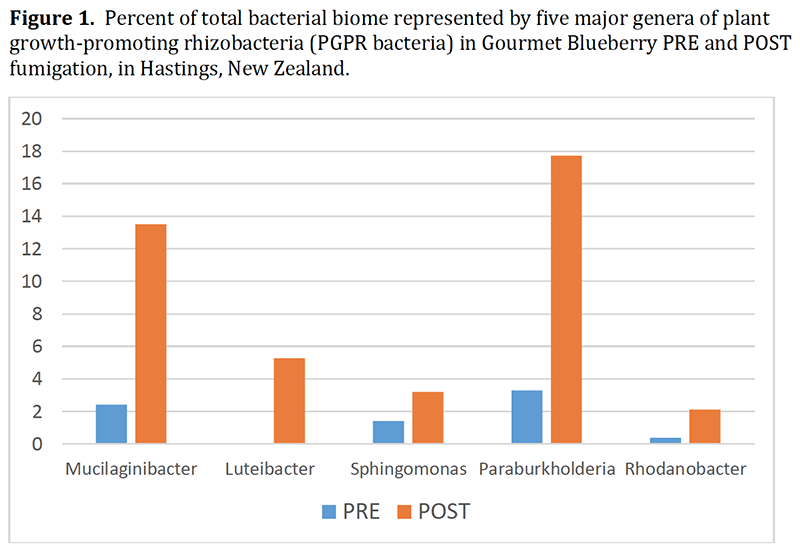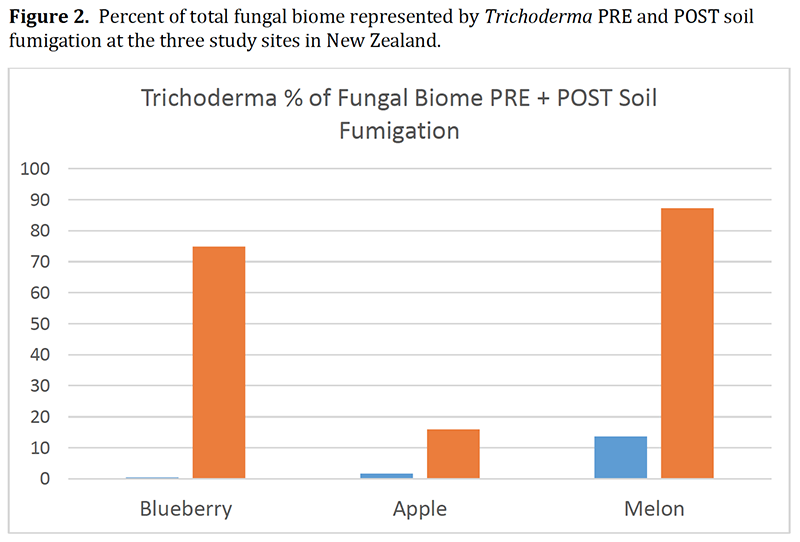The following reports the results of recent research carried out by Brian Leicester (Leicesters Soil Solutions) and Dr. John Washington (US-based plant pathologist and microbiologist, and research and development director at the Trical Group, based in Florida, USA) into soil biome in apples, melons and blueberries in New Zealand. These results relate to the 2022 article titled ‘Debunking Myths Around Soil Fumigants & Their Impact On Soil Health’, which can be found here.
Leicesters Soil Solutions (New Zealand) and Trical Group (www.tricalgroup.com) wanted a closer look at soil microbiology and how the soil biome changed in response to soil fumigation at three study sites in New Zealand during 2022. These studies were initiated as part of the Trical Group’s efforts to develop a more precise understanding of the specific effects of the soil fumigants chloropicrin and 1,3-D on soil microbiology and soil health. A previous article, “Debunking myths around soil fumigants and their impact on soil health” (NZ Grower, May 2022), provided some background information on this subject and the objectives of studies in New Zealand by the authors.
Comparing Soil Microbial Populations In Agricultural Soils Before & After Soil Fumigation
The field studies have been completed and we have full data sets from three different crops and locations in New Zealand, utilizing the powerful, high-throughput, genetic sequencing services of Biome Makers (www.biomemakers.com) to compare soil microbial populations (soil biome) in agricultural soils before and after (30 days) soil fumigation. The study sites were located at Gourmet Blueberry in Hastings, an apple orchard at Stallard Farms in Hastings, and a melon production area at Mofett Farms, in Napier. Upon completion of the soil biome quantification by Biome Makers, the authors used the raw data files to sort, rank and interpret specific bacterial and fungal changes from each sample date and for each treatment, and then summarized in reports for each study location (available upon request) which highlighted major trends illustrating how the soil biome changed as a result of soil fumigation.
Major Positive Shifts In The Composition Of The Soil Microbial Populations In Response To Soil Fumigation
Biome shifts that really stand out include major increases in plant growth-promoting bacteria (Figure 1), such as the bacterial genera (plural of Genus) Micromonospora, Sphinghomonas, Flavobacterium, Mucilaginibacter, Gemmatimonas, Luteibacter, Paraburkholdería and the important fungal genera Mortierella, Chaetomium, Mucor, Aspergillus, Penicillium, and many more. Collectively, the data demonstrate major, positive shifts in the composition of the soil microbial populations in response to soil fumigation, including many microbes which are known to benefit crop growth.
Trichoderma Rose To Very High Levels At All Study Sites
Another fascinating aspect of these studies is that the fungus Trichoderma rose to very high levels at all study sites following soil fumigation (Figure 2). Trichoderma is a very well-known beneficial fungus in the soil that plays a major role in inducing plant resistance to disease as well as being a proven biological control agent and antibiotic producer. We know from other studies across the globe as well as many published scientific papers that Trichoderma increases dramatically in response to chloropicrin. This is due to the fact that this fungus is an excellent opportunist, exploiting the availability of food sources from dead microbes that ensue following fumigation, and quickly proliferates in the soil environment.

xxx

These studies in New Zealand soils show interesting results on how the soil biome changed in response to soil fumigation with soil fumigants Chloropicrin and 1,3-D. Telone, revealing a healthy, native soil biome in growers’ fields that is highly favorable for crop growth.


